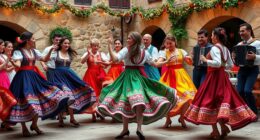Venetian rowing, or voga alla veneta, is a traditional technique that combines a specific boat design with fluid, graceful strokes. You’ll notice the boats are long, lightweight, and flat-bottomed, perfect for narrow canals. The rowing style emphasizes harmony, finesse, and controlled movements, allowing you to navigate Venice’s waterways with skill and respect. If you keep exploring, you’ll uncover more about this elegant heritage and how it continues to thrive today.
Key Takeaways
- Voga Alla Veneta is a traditional Venetian rowing style emphasizing graceful, fluid movements over brute force.
- The specialized boat design, including a long, slender, flat-bottomed craft, supports precise maneuvering and elegant strokes.
- Rowing technique focuses on synchronization, relaxed posture, and smooth, controlled oars to navigate Venice’s narrow waterways.
- Etiquette emphasizes respect, subtle communication, and safety, maintaining harmony among rowers, gondolas, and pedestrians.
- This tradition embodies Venice’s cultural heritage, combining boat craftsmanship and refined skills passed down through generations.

Have you ever wondered how Venetians glide through the city’s canals with such skill and elegance? It’s all about the unique combination of boat design and rowing etiquette that makes traditional Venetian rowing, or Voga Alla Veneta, so enthralling. The boats used in this technique are specifically crafted for the narrow, winding waterways of Venice. They are long, slender, and lightweight, allowing for quick turns and precise maneuvering. These boats often feature a flat bottom, which provides stability in the shallow waters, and a pointed bow that cuts smoothly through the water. The design emphasizes simplicity and functionality, enabling rowers to move swiftly and with minimal effort. This focus on boat design is essential because it supports the distinctive rowing style and the delicate balance needed to navigate Venice’s intricate canal system. Incorporating natural elements such as water and air into the practice can deepen the connection between rower and environment, enhancing the traditional experience.
When you step into a Venetian voga boat, you quickly realize that mastering the craft involves more than just physical strength; it demands a deep understanding of rowing etiquette. This etiquette isn’t just about politeness—it’s about respecting the shared space of Venice’s waterways. You’ll learn to communicate with subtle gestures and a shared sense of rhythm with other rowers, ensuring smooth traffic flow in busy canals. The proper way to handle the oar involves specific techniques: keeping your back straight, using your core rather than just your arms, and maintaining a steady, controlled stroke. These practices help conserve energy and prevent accidents, especially in crowded areas. Adhering to rowing etiquette also means being mindful of pedestrians, gondolas, and other boats, giving way when necessary and avoiding abrupt movements that could cause collisions.
The Voga Alla Veneta technique places emphasis on fluid, graceful motion. It’s not about brute force but about harmony and finesse. You’ll be taught to synchronize your movements with your breathing and to maintain a relaxed posture, which allows for longer, more efficient strokes. This style of rowing preserves Venice’s historical traditions, passing down skills that have been refined over centuries. The connection between boat design and rowing etiquette is clear: the boat’s shape supports the smooth, elegant strokes, while etiquette ensures respectful, safe navigation. As you learn and practice, you’ll discover that this way of rowing isn’t just a mode of transportation—it’s an art form rooted deeply in Venetian culture. Ultimately, when you glide through the canals, you’re not just moving from point A to point B—you’re participating in a living tradition that embodies the grace and ingenuity of Venice itself.
Frequently Asked Questions
How Did the Voga Alla Veneta Originate Historically?
You might find it fascinating that voga alla veneta originated as a practical maritime heritage in Venice, dating back centuries. This rowing style developed to navigate the city’s canals efficiently, becoming a essential part of cultural preservation. As fishermen and gondoliers perfected their skills, they passed down these techniques through generations, ensuring the tradition remains alive today. Your participation helps keep this unique maritime heritage thriving for future Venetians.
What Are the Main Differences Between Voga Alla Veneta and Modern Rowing?
You’ll notice that voga alla veneta feels like a dance on water, with a relaxed, upright rowing posture that emphasizes grace and control. Unlike modern rowing, which uses sleek, technical equipment and a forward-leaning stance, Venetian rowing relies on simple, traditional boats and a more intuitive, flowing technique. This difference creates a connection to history, blending elegance with functionality, setting it apart from the more competitive, streamlined modern style.
Are There Specific Boats Used Exclusively for Voga Alla Veneta?
Yes, there are specific Venetian boat types used exclusively for voga alla veneta. These boats, like the gondolini and bragozzo, are designed for traditional Venetian rowing competitions and practice. Their lightweight, narrow structure allows for agility and speed, making them ideal for the Voga Alla Veneta technique. You’ll notice these boats in local races and festivals, showcasing the skill and heritage of Venetian rowing traditions.
How Has the Technique Evolved Over Centuries?
You’ve seen how voga alla veneta has evolved over centuries through evolutionary adaptations and technique modernization. You notice that rowers have refined their movements, focusing on efficiency and balance. The boats have also changed, becoming lighter and more streamlined. These updates allow you to row more smoothly and quickly, blending tradition with innovation. Overall, the technique continues to adapt, preserving its essence while embracing new methods for better performance.
Can Tourists Participate in Traditional Venetian Rowing Activities?
You can definitely immerse yourself in Venetian waters and become part of the dance of the canals. Tourist participation in traditional rowing activities offers a chance to learn the art firsthand through engaging rowing workshops. As you grasp the oar, you’ll feel the pulse of Venice itself, weaving your story into its timeless tapestry. These experiences turn you into a temporary Venetian, gliding gracefully through history and water.
Conclusion
As you glide through the canals, embracing the grace of voga alla veneta, you connect with centuries of Venetian tradition—no hoverboard needed here. Feel the rhythm of the oar, imagine gondolas past, and savor this timeless dance on water. Just like sailors once did, you become part of Venice’s living history, proof that true craftsmanship, even in a world of smartphones, still navigates us through life’s currents—like a classic Venetian melody echoing into the future.









